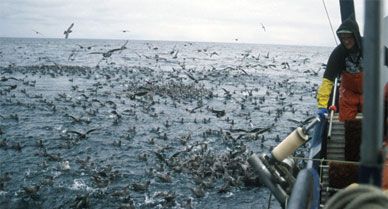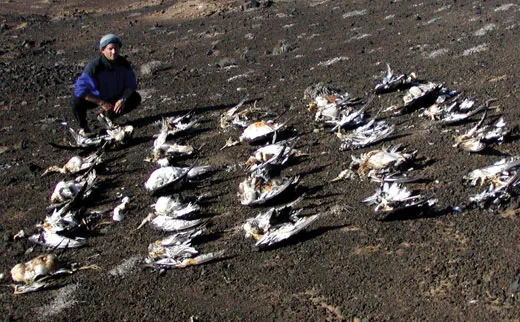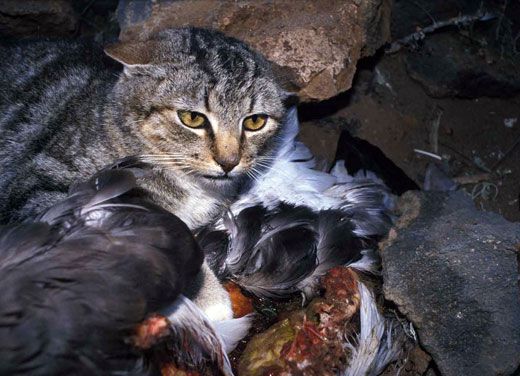Going “Bycatch Neutral”
Can fisheries eliminate their debts to nature?
/https://tf-cmsv2-smithsonianmag-media.s3.amazonaws.com/filer/bycatch631.jpg)
When fisheries catch too many seabirds and sea turtles, forcing them to adopt safer practices, or even closing them entirely, seems environmentally responsible. The story, however, isn't always that simple.
In 2004, fresh off a three-year suspension for having too many interactions with endangered sea turtles, the Hawaii longline swordfish fishery resumed operation. This time around, the fishery's vessels were fitted with turtle-friendly hooks and the regulatory ballast of observers sent to enforce the annual limit of 17 turtle tangles. The trick seemed to work. In 2004 and 2005, the new hooks decreased turtle catches by about 90 percent, according to research published this month in Biological Conservation.
But come 2006, swordfish demand spiked. The Hawaii fishery's vessels stormed the sea early that season, says the paper's lead author Eric Gilman, director of the Blue Ocean Institute's fisheries bycatch program. They wanted to capitalize on the market, and they wanted to capitalize quickly, fearing another bycatch closure. Despite the safer hooks, the sheer volume of longlines led to a closure in March. On top of that, when the fishery closed, evidence suggests that illegal boats swept in for the spoils—likely without safe techniques. Ironically, in this instance, punishing a fishery for bycatch violations probably harmed the very animals these sanctions aimed to save.
One case aside, even the best available fishing equipment and regulations will result in a few stray snags. That's a problem for countries like Australia, whose progressive marine conservation policy strives for "zero bycatch of seabirds, especially threatened albatross and petrel species." For some albatross species, catching even a handful of birds could harm the population. And all seven species of sea turtles are listed as threatened or worse.
Interestingly, there's a threat to seabirds and turtles that's comparable to, if not greater than, fishery bycatch—and it's this additional danger that might help save some species, argues a team of conservationists in a recent issue of Frontiers in Ecology and the Environment. Introduced predators, such as cats and rodents, threaten 75 percent of endangered seabirds on their breeding islands; bycatch threatens only half of seabird species. These dual threats actually present an opportunity for fisheries to go "bycatch neutral." The idea is this: Instead of shutting down fleets that catch more seabirds and turtles than they should, these fisheries would instead fund efforts to remove predators from breeding islands.
"Even in the best-managed fisheries, accidents happen," says Chris Wilcox, coauthor of the paper and a senior marine scientist at the Commonwealth Scientific and Industrial Research Organisation in Australia. "One could effectively go back and make up for these mistakes." In the long run, the amount of animals saved on land could offset, or even surpass, the amount killed at sea.
Take Australia's eastern tuna and billfish fishery. The fleet annually kills thousands of flesh-footed shearwaters, which breed on Lord Howe Island and may be in decline. Closing off the fishery from areas around the island would cost some $3 million and increase shearwater growth 6 percent, calculate Wilcox and coauthor Josh Donlan of Cornell University. Eradicating rats from the island, however, would cost only half a million dollars and boost the seabird population 32 percent.
The examples go on. As Kennedy Warne points out in the September Smithsonian, mice on Gough Island are decimating petrels and Tristan albatross—the third rarest albatross species. The invasive mice are having such an impact that the albatross population on Gough would continue to decline even if longlines stopped killing birds near the island, says biologist Ross Wanless of the University of Cape Town in South Africa, who published a paper on Gough's mouse problem in a June issue of Biology Letters. All told, over half the seabird species threatened by bycatch are also threatened by introduced predators, Wilcox and Donlan report.
"The concept is exciting," says marine scientist Ed Melvin of Washington Sea Grant. "It creates an economic incentive to improve [fishing methods] and, at the same time, any money that is spent goes directly back into the species."
The idea of compensating for environmental loss has precedence. Several U.S. regulations, namely the Clean Water Act, have compelled businesses to restore wetlands in situations where destroying these areas was deemed unavoidable. But the success of this "wetland neutral" policy is, some might say, a bit mushy. Though restored wetlands occasionally come close to replicating the original in terms of species inclusion and ecological function, a 2001 National Academy of Sciences report on the topic concluded that the goal of "no net loss" of wetlands hadn't been met.
What's more, compensation projects, however promising, can be construed as a fallback for those who might not have to do damage in the first place, says restoration ecologist Joy B. Zedler of the University of Wisconsin at Madison, who led the 2001 report. "I don't like when it becomes an enabling process," Zedler says. "We don't have to damage something, but someone says, 'Hey, I can make something here, and I'm allowed to damage something there.'" The same mindset plagues the "carbon neutral" industry, where people often pay for carbon offsets that are "only estimated, extrapolated, hoped-for or nil" yet consider their debts paid in full, as the Washington Post recently reported.
Comparing birds to birds or turtles to turtles would likely be more straightforward than comparing wetlands, with their complex and shifting systems of biodiversity, or carbon atoms, with their invisible ubiquity. Still, other complications remain. Some of the plan's critics wonder if governments that are supposed to control invasive island species would see the concept as a way to pass the burden onto fisheries. Others ask whether fisheries would pay for onboard observers, which would greatly increase overhead, or if policymakers could convince taxpayers to bear the cost. "You can't have all the fish you want, at bargain-basement prices, and sustainability too," Wilcox says. In other words, we all want to be responsible—until it's time to find out who's responsible.
The main thing to keep in mind, says Wilcox, is that any bycatch neutral strategy should be a third line of defense—behind using the safest possible fishing equipment and avoiding marine life interactions entirely. For that reason, the idea has gained traction among conservationists. A similar concept, involving a tax that would go toward conserving species harmed by bycatch, is being crafted independently by the United Nations Food and Agricultural Organization for its upcoming guidelines for responsible fisheries, Gilman says. Another related plan, in which a conservation fee might be imposed on individual ships with high bycatch rates, is even being considered for the Hawaii fishery, he says. As of publication, the fishery had completed the peak of its 2007 season with three turtle interactions to spare.
/https://tf-cmsv2-smithsonianmag-media.s3.amazonaws.com/accounts/headshot/eric-jaffe-240.jpg)



/https://tf-cmsv2-smithsonianmag-media.s3.amazonaws.com/accounts/headshot/eric-jaffe-240.jpg)